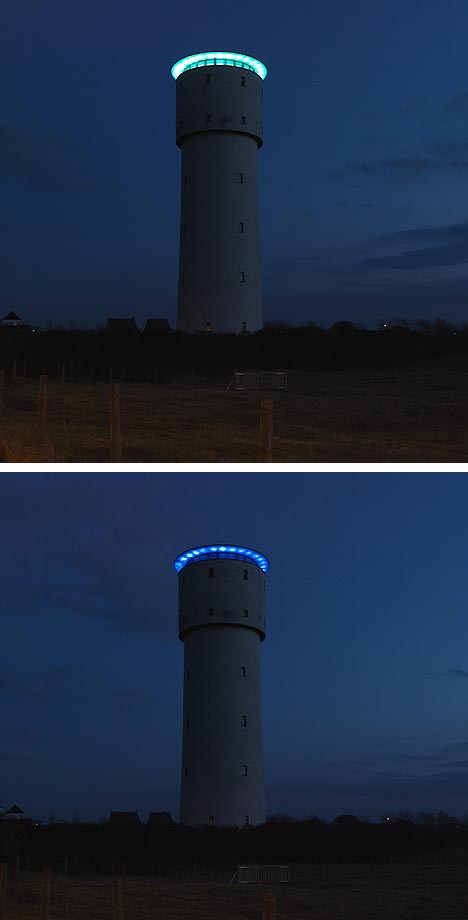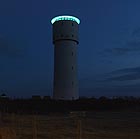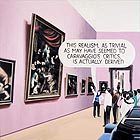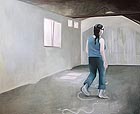
translated and summarized by: Liz Wollner-Grandville,
Engish summary July 1 - 5
Belgian Coast: Beaufort03
Target group dynamics
Jetsam, flotsam, cultural goods. The wind is blowing in all directions on the Belgian North Sea coast of Flanders, presumably at bearable Beaufort gusts. Beaufort: a storm of art, projects, and installations is blowing along the Flemish coast until October 4. Sir Francis Beaufort, born 1774 in Ireland, developed this wind speed scale, which is still valid today. It divides the wind into 12 classes - from 0 (calm) to 12 (hurricane).
And this part of the coast is also turning more and more into a touristic crisis region; another reason why many works of this international art triennial are located directly at the seaside and can easily be reached wearing a swimsuit – and if it rains, there isn’t much else to do anyway.
Beaufort03 is one of many bi-, tri-, and quadrennials around the globe; every fourth day a new one opens its gates. At the beach near Bredene, the milky skyline of Ostend in the background, a journalist working for La Stampa discovers a limp red balloon with a little note attached to it. “Marieke and Gerry, soon we will be a threesome”. This discovery forms a surreal connection to a rusty, octahedron dice-like creature, which somehow ended up on the beach: jetsam, flotsam, cultural goods? A garbled German-language sign attempts to give detailed information and a German-language “Art- and Coast Guide” provides diverse tips on hiking and biking. Contributions from German artists are displayed at Blankenberg’s Pier and Ostend. Among them: an “Ikarus” by Lothar Hempel, and a huge concrete wall by Harald Klingelhöller at the Ostend Museum.
The rusty dice-like creature mentioned afore is named “Metatron” and was created by Louis de Cordier. Other works shown along the coast are a painted cuboid by the American artist Sterling Ruby, which attempts to soak up the rainbow-like dramatic atmosphere, Niek Kemp’s red steel pavilion maze, ducking in the white sand. Aneas Wilder’s 12 meter high wooden dome installed in Middlekerke-Westende and Tamar Frank’s water tower, its roof immersed into green neon-light. Evan Holloway set a huge sail made of silver and copper mesh. On the sail one can read the words: “Never good enough”. Daniel Buren’s striped wind sleeves attached to poles at the beach of De Haans are a pleasant decoration. Architecture and nature, like Jason meadow’s “Plopsaland” Blowups, provide for one of the dialogues at this third “Beaufort” project. The other dialogue is provided by contemporary art’s answer to the history of the Flemish coastal strip. Such as the remains of a feigned floor plan of the Ten Duinen Abbey (1138) in Kojksijde by the Dutch artist Krijn de Koning. The Belgian Philip Aguirre created a boat-memorial to remind of the refugee problem. Following a journey to Senegal, Aguierre installed one of these tragic ship constructions perpendicular to the sky, which resembles cemetery chapel offering informative content on misery.
Belgian ocean-art-history and reminiscences of the years 1830 to 1958 are presented at the “Art Museum at Sea” in Ostend – including interiors and seascapes, and contributions by Margritte, Ensor or Permeke. In view of the concrete frontier along nearly the entire Belgian coastline, the Belle Epoque posters appear like a farewell, Some target group tactics were intentional: the Avant-gardists out towards the contemporary sea, the lovers of tradition into the museum on Romestraat 11.
By Roland Groß
Belgian Coast
until 04.10.09
www.beaufort03.be
Bawag Contemporary: Young and Reckless 8: Franz Erhard Walther
Through the atlas of the Avant-garde
Off we go. Back to the present. Into the contemporary. The motto “Young & Reckless” for the BAWAG Contemporary exhibitions is a popular one. But it has nothing to do with a youth cult referring to biological age. Franz Erhard Walther is more an old valiant than reckless. Not carefree, but a responsible pioneer, whose concepts influenced generations of artists. Already in the 1960s, Kaspar König published Walther’s first art book, and in 1969, Harald Szeemann presented Walther’s works at the legendary “When Attitudes become Form” exhibit in Bern and London – this adumbrates the context in which the then only 30 year-old artist was presented. Walther was the mastermind behind a new perception of art. His artefacts, e.g. a rope and “two auburn velvet cushions” (filled and empty) were not aimed at representing especially aesthetic qualities, but as functional instruments. They were to be perceived as invitations, requests, as something to, to handle, to deal with. The artist released them for mental dialogues, whose meaning was no longer determined by their producer, but by their recipients. Similar to how a differentiation was met between the meaning of significant and significant since the 19th century, the classical unity of the work disintegrated into a material object and individualised attributions of meaning. In the background one could faintly hear Duchamp’s voice. The dialectic composed of a verbalized idea and letting go was essential. This was especially valid for Walther’s text pieces. He had already experimented with liquids on paper, and not only used it as the carrier of clearly defined interpretations, but to integrate variances of the surface into his work. In addition: installations with textiles and later different types of bases, wall formations or space filling installations.
But the new options of experience established by Franz Erhard Walther did not lead to the final denouement of his work. This is demonstrated by the BAWAG Contemporary’s facsimile presentation of Walther’s, soon to be published, autobiography. “Sternenstaub – ein gezeichneter Roman” (Stardust - a sketched novel) was created between 2007 and 2008. It represents an atlas leading through the history of the Euro-American postwar Avant-garde - seen from a personal point of view. It is impossible to read all 524 pages at the exhibition. But no matter where one zooms into his work, which reminds of a combination of storyboards and an art sketch book or Rirkrit Tiravanija’s documentary drawings, and which is broader than cinemascope, one always encounters an artist who reflects the development of art and always questions what it means to be “contemporary”. This is a decisive moment at this exhibition - in which relations are adjusted.
By Roland Schöny
BAWAG Contemporary
1060 Vienna, Barnabitengasse 11-13, until 02.08.09
www.bawagcontemporary.at
Galerie Meyer Kainer: Marcin Maciejowski
Irony, worship, tenderness
Stories about painting cannot be more truthful than the painting itself. And it is especially pleasing if a painter uses these stories as his main subject. For his third solo exhibit at Meyer Kainer, Marcin Maciejowski almalgamated elements found in pop art and comics with unconventional photography-like prima tempera painting. “This realism is trivial” (oil on canvas, 150x150, 2009) depicts an attentive group of visitors in front of Caravaggio’s rosary Madonna, listening to a lady guide lecturing competently about the painting in the painting. The English words in the speech bubble give an insight on realism, triviality, criticism, and origin. Through Maciejowski’s side-view, the arrogant mien of Caravaggio’s Madonna is not visible nor is that of the lady with the speech bubble; everything personal is reduced to the general physiognomy. The artist often refrains from adding facial details. One could think he has something against portraits, but that’s definitely not the case.
Six portraits of three composers are displayed in the upstairs Boltenstern room – in black-white-grey tones. A closer look at these works reveals movements, which in their lust and suppleness surpass the curves of most top models. But all of the 9 ladies posing in beautiful clothes are faceless. While the artist knows who the ladies are, he considered their clothes, their shimmer, the fall of the folds and the form of the bodies much more important than the depiction of their faces. The minimalistic cleverly thought out painting, which expresses this texture fascination, is so superb and delightful, that alone by looking at the dress one can feel it on ones own body. There was clearly nothing misogynistic in his work.
“The phantasmagorical level of the picture” (oil on canvas, 2009, 120x100): a young woman with a pensive look and cross-my- heart demeanour is shown contemplating over an opened catalogue, and contemplating how one could penetrate the filling level of a perfect dream (“you seem to penetrate the phantasmagorical level…”). From the bottom part of the picture, the position of the viewer, the thoughts are confirmed “just so”. The irony of worship could not be set into the picture more delicately. And this irony does not only affect worshiping things that are difficult to comprehend, but also worshipping the making of a painting as such; for a painter like Marcin Madiejoswski it is imperative to create paintings, which should be seen. Allowed – just so.
By Gesche Heumann
Galerie Meyer Kainer
1010 Vienna, Eschenbachgasse 9, until 31.07.09
www.meyerkainer.com
Galerie Gerersdorfer: Ramona Proyer – Début
Lonely creatures and crazy architecture
With her first solo exhibition “Début”, Ramona Proyer proves that she is a talented painter with potential – even if –especially her picture composition and colouring scheme – seem somewhat immature. Her large oil paintings always depict a person either without a facial expression or turned away in a room or a landscape - and are something like a citation of romanticism in their distanced superficiality. Just think of Caspar David Friedrich’s “Wanderer übers Nebelmeer” (1818). But at the same time they are also – not quite illogical – their antithesis. Here the lonely figures are not glorified, but they are what they are: lost and insignificant in a sterile environment reminding of computer games.
The possibly dangerous tricks utlized by the young artist – in the tradition of romantic irony – to break the smooth worlds, are those of applying a false perspective and an erratic space continuum. Proof that she can master these tricks is the 135 by 165 cm large oil painting titled “Simulacrum”, in which she subtly lets the shadows fall differently than expected and implies pillars on the wall by painting their empty bases on the ground.
The strength of her works lies in these slightly crazy rooms and the somewhat spooky superficiality of the paintings. It is clearly not a coincidence that her works remind of her nearly same-aged gallery colleague Robert Muntean.
By Wolfgang Pichler
Galerie Gerersdorfer
1090 Vienna, Währinger Strasse 12, until 11.07.09
www.gerersdorfer.at
Mehr Texte von translated and summarized by: Liz Wollner-Grandville


 Teilen
Teilen




